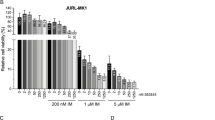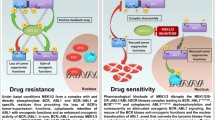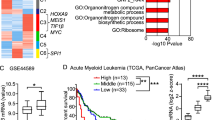Abstract
Allogeneic stem cell transplantation (allo-SCT) is a potentially curative therapy for chronic myeloid leukemia and Philadelphia chromosome-positive (Ph(+)) acute lymphoblastic leukemia, and the graft-vs-leukemia (GVL) effect can eradicate residual leukemia after allo-SCT. Ph(+) leukemia cells frequently express death-inducing receptors (DR4 and DR5) for tumor necrosis factor-related apoptosis-inducing ligand (TRAIL), which is one of the cytotoxic ligands expressed on cytotoxic T cells and natural killer cells mediating the GVL effect. Here we demonstrate that imatinib specifically downregulated DR4 and DR5 expression in cell lines and clinical samples of Ph(+) leukemia. Second-generation tyrosine kinase inhibitors (dasatinib and nilotinib) and short hairpin RNA against bcr-abl also downregulated DR4 and DR5 expression in Ph(+) leukemia cells, and transfection of bcr-abl into a Ph(−) leukemia cell line induced DR4 and DR5 expression, which was abrogated by imatinib treatment. Accordingly, Ph(+) leukemia cells that had been pretreated with imatinib showed resistance to the pro-apoptotic activity of recombinant human soluble TRAIL. These observations demonstrate that BCR-ABL is critically involved in the leukemia-specific expression of DR4 and DR5 and in the susceptibility of Ph(+) leukemia to TRAIL-mediated anti-leukemic activity, providing new insight into the mechanisms of the tumor-specific cytotoxic activities of TRAIL.
This is a preview of subscription content, access via your institution
Access options
Subscribe to this journal
Receive 50 print issues and online access
$259.00 per year
only $5.18 per issue
Buy this article
- Purchase on SpringerLink
- Instant access to full article PDF
Prices may be subject to local taxes which are calculated during checkout







Similar content being viewed by others
References
Faderl S, Talpaz M, Estrov Z, O’Brien S, Kurzrock R, Kantarjian HM . The biology of chronic myeloid leukemia. N Engl J Med 1999; 341: 164–172.
Hehlmann R, Hochhaus A, Baccarani M . European LeukemiaNet. Chronic myeloid leukaemia. Lancet 2007; 370: 342–350.
Quintás-Cardama A, Cortes J . Molecular biology of bcr-abl1-positive chronic myeloid leukemia. Blood 2009; 113: 1619–1630.
Preti HA, O’Brien S, Giralt S, Beran M, Pierce S, Kantarjian HM . Philadelphia-chromosome-positive adult acute lymphocytic leukemia: characteristics, treatment results, and prognosis in 41 patients. Am J Med 1994; 97: 60–65.
Uckun FM, Nachman JB, Sather HN, Sensel MG, Kraft P, Steinherz PG et al. Clinical significance of Philadelphia chromosome positive pediatric acute lymphoblastic leukemia in the context of contemporary intensive therapies: a report from the Children’s Cancer Group. Cancer 1998; 83: 2030–2039.
Druker BJ, Tamura S, Buchdunger E, Ohno S, Segal GM, Fanning S et al. Effects of a selective inhibitor of the Abl tyrosine kinase on the growth of Bcr-Abl positive cells. Nat Med 1996; 2: 561–566.
Druker BJ, Talpaz M, Resta DJ, Peng B, Buchdunger E, Ford JM et al. Efficacy and safety of a specific inhibitor of BCR-ABL tyrosine kinase in chronic myeloid leukemia. N Engl J Med 2001; 344: 1031–1037.
Druker BJ, Sawyers CL, Kantarjian H, Resta DJ, Reese SF, Ford JM et al. Activity of a specific inhibitor of the BCR-ABL tyrosine kinase in the blastic crisis of chronic myeloid leukemia and acute lymphoblastic leukemia with the Philadelphia chromosome. N Engl J Med 2001; 344: 1038–1042.
Jabbour E, Hochhaus A, Cortes J, La Rosée P, Kantarjian HM . Choosing the best treatment strategy for chronic myeloid leukemia patients resistant to imatinib: weighing the efficacy and safety of individual drugs with BCR-ABL mutations and patient history. Leukemia 2010; 24: 6–12.
Jabbour E, Kantarjian H, O’Brien S, Shan J, Garcia-Manero G, Wierda W et al. Predictive factors for outcome and response in patients treated with second-generation tyrosine kinase inhibitors for chronic myeloid leukemia in chronic phase after imatinib failure. Blood 2011; 117: 1822–1827.
Arico M, Valsecchi MG, Camitta B, Schrappe M, Chessells J, Baruchel A et al. Outcome of treatment in children with Philadelphia chromosome-positive acute lymphoblastic leukemia. N Engl J Med 2000; 342: 998–1006.
Fielding AK . How I treat Philadelphia chromosome-positive acute lymphoblastic leukemia. Blood 2010; 116: 3409–3417.
Kolb HJ, Schmid C, Barrett AJ, Schendel DJ . Graft-versus-leukemia reactions in allogeneic chimeras. Blood 2003; 103: 767–776.
Kolb HJ . Graft-versus-leukemia effects of transplantation and donor lymphocytes. Blood 2008; 112: 4371–4383.
Kagi D, Vignaux F, Ledermann B, Depraetere V, Nagata S, Hengartner H et al. Fas and perforin pathways as major mechanisms of T cell-mediated cytotoxicity. Science 1994; 265: 528–530.
Lowin B, Hahne M, Mattmann C, Tschopp J . Cytolytic T-cell cytotoxicity is mediated through perforin and Fas lytic pathways. Nature 1994; 370: 650–652.
Smyth MJ, Cretney E, Takeda K, Wiltrout RH, Sedger LM, Kayagaki N et al. Tumor necrosis factor-related apoptosis-inducing ligand (TRAIL) contributes to interferon gamma-dependent natural killer cell protection from tumor metastasis. J Exp Med 2001; 193: 661–670.
Takeda K, Hayakawa Y, Smyth MJ, Kayagaki N, Yamaguchi N, Kakuta S et al. Involvement of tumor necrosis factor-related apoptosis-inducing ligand in surveillance of tumor metastasis by liver natural killer cells. Nat Med 2001; 7: 94–100.
Cretney E, Takeda K, Yagita H, Glaccum M, Peschon JJ, Smyth MJ . Increased susceptibility to tumor initiation and metastasis in TNF-related apoptosis-inducing ligand-deficient mice. J Immunol 2002; 168: 1356–1361.
Takeda K, Smyth MJ, Cretney E, Hayakawa Y, Kayagaki N, Yagita H et al. Critical role for tumor necrosis factor-related apoptosis-inducing ligand in immune surveillance against tumor development. J Exp Med 2002; 195: 161–169.
Schmaltz C, Alpdogan O, Kappel BJ, Muriglan SJ, Rotolo JA, Ongchin J et al. T cells require TRAIL for optimal graft-versus-tumor activity. Nat Med 2002; 8: 1433–1437.
Takeda K, Stagg J, Yagita H, Okumura K, Smyth MJ . Targeting death-inducing receptors in cancer therapy. Oncogene 2007; 26: 3745–3757.
Pan G, O’Rourke K, Chinnaiyan AM, Gentz R, Ebner R, Ni J et al. The receptor for the cytotoxic ligand TRAIL. Science 1997; 276: 111–113.
Pan G, Ni J, Wei YF, Yu G, Gentz R, Dixit VM . An antagonist decoy receptor and death domain-containing receptor for TRAIL. Science 1997; 277: 815–821.
Uno K, Inukai T, Kayagaki N, Goi K, Sato H, Nemoto A et al. TNF-related apoptosis-inducing ligand (TRAIL) frequently induces apoptosis in Philadelphia chromosome-positive leukemia cells. Blood 2003; 101: 3658–3667.
Gonzalvez F, Ashkenazi A . New insights into apoptosis signaling by Apo2L/TRAIL. Oncogene 2010; 29: 4752–4765.
Zhang X, Inukai T, Akahane K, Hirose K, Kuroda I, Honna H et al. Endoplasmic reticulum stress inducers, but not imatinib, sensitize Philadelphia chromosome-positive leukemia cells to TRAIL-mediated apoptosis. Leuk Res 2011; 35: 940–949.
Sheridan JP, Marsters SA, Pitti RM, Gurney A, Skubatch M, Baldwin D et al. Control of TRAIL-induced apoptosis by a family of signaling and decoy receptors. Science 1997; 277: 818–821.
Hirase C, Maeda Y, Takai S, Kanamaru A . Hypersensitivity of Ph-positive lymphoid cell lines to rapamycin: possible clinical application of mTOR inhibitor. Leuk Res 2009; 33: 450–459.
Akahane K, Inukai T, Zhang X, Hirose K, Kuroda I, Goi K et al. Resistance of T-cell acute lymphoblastic leukemia to tumor necrosis factor-related apoptosis-inducing ligand-mediated apoptosis. Exp Hematol 2010; 38: 885–895.
Nimmanapalli R, Porosnicu M, Nguyen D, Worthington E, O’Bryan E, Perkins C et al. Cotreatment with STI-571 enhances tumor necrosis factor alpha-related apoptosis-inducing ligand (TRAIL or apo-2L)-induced apoptosis of Bcr-Abl-positive human acute leukemia cells. Clin Cancer Res 2001; 7: 350–357.
Hess G, Bunjes D, Siegert W, Schwerdtfeger R, Ledderose G, Wassmann B et al. Sustained complete molecular remissions after treatment with imatinib-mesylate in patients with failure after allogeneic stem cell transplantation for chronic myelogenous leukemia: results of a prospective phase II open-label multicenter study. J Clin Oncol 2005; 23: 7583–7593.
Carpenter PA, Snyder DS, Flowers ME, Sanders JE, Gooley TA, Martin PJ et al. Prophylactic administration of imatinib after hematopoietic cell transplantation for high-risk Philadelphia chromosome-positive leukemia. Blood 2007; 109: 2791–2793.
Olavarria E, Siddique S, Griffiths MJ, Avery S, Byrne JL, Piper KP et al. Posttransplantation imatinib as a strategy to postpone the requirement for immunotherapy in patients undergoing reduced-intensity allografts for chronic myeloid leukemia. Blood 2007; 110: 4614–4617.
Savani BN, Montero A, Kurlander R, Childs R, Hensel N, Barrett AJ . Imatinib synergizes with donor lymphocyte infusions to achieve rapid molecular remission of CML relapsing after allogeneic stem cell transplantation. Bone Marrow Transplant 2005; 36: 1009–1015.
Yoshimitsu M, Fujiwara H, Ozaki A, Hamada H, Matsushita K, Arima N et al. Case of a patient with Philadelphia-chromosome-positive acute lymphoblastic leukemia relapsed after myeloablative allogeneic hematopoietic stem cell transplantation treated successfully with imatinib and sequential donor lymphocyte infusions. Int J Hematol 2008; 88: 331–335.
Tiribelli M, Sperotto A, Candoni A, Simeone E, Buttignol S, Fanin R . Nilotinib and donor lymphocyte infusion in the treatment of Philadelphia-positive acute lymphoblastic leukemia (Ph+ ALL) relapsing after allogeneic stem cell transplantation and resistant to imatinib. Leuk Res 2009; 33: 174–177.
Inukai T, Sugita K, Suzuki T, Ijima K, Goi K, Tezuka T et al. A novel 203 kD aberrant BCR-ABL product in a girl with Philadelphia chromosome positive acute lymphoblastic leukaemia. Br J Haematol 1993; 85: 823–825.
Yoshida T, Maeda A, Tani N, Sakai T . Promoter structure and transcription initiation sites of the human death receptor 5/TRAIL-R2 gene. FEBS Lett 2001; 507: 381–385.
Rubinson DA, Dillon CP, Kwiatkowski AV, Sievers C, Yang L, Kopinja J et al. A lentivirus-based system to functionally silence genes in primary mammalian cells, stem cells and transgenic mice by RNA interference. Nat Genet 2003; 33: 401–406.
Hirose K, Inukai T, Kikuchi J, Furukawa Y, Ikawa T, Kawamoto H et al. Aberrant induction of LMO2 by the E2A-HLF chimeric transcription factor and its implication in leukemogenesis of B-precursor ALL with t(17;19). Blood 2010; 116: 962–970.
Acknowledgements
The authors thank technological supports by Masako Abe. This work was supported in part by research grants from the Ministry of Education, Science and Culture, Japan.
Author information
Authors and Affiliations
Corresponding author
Ethics declarations
Competing interests
The authors declare no conflict of interest.
Rights and permissions
About this article
Cite this article
Kuroda, I., Inukai, T., Zhang, X. et al. BCR-ABL regulates death receptor expression for TNF-related apoptosis-inducing ligand (TRAIL) in Philadelphia chromosome-positive leukemia. Oncogene 32, 1670–1681 (2013). https://doi.org/10.1038/onc.2012.186
Received:
Revised:
Accepted:
Published:
Issue date:
DOI: https://doi.org/10.1038/onc.2012.186
Keywords
This article is cited by
-
The Philadelphia chromosome in leukemogenesis
Chinese Journal of Cancer (2016)
-
While at Rome miRNA and TRAIL Do Whatever BCR-ABL Commands to Do
Archivum Immunologiae et Therapiae Experimentalis (2013)



